The digital economy is dominated by services, which accounted for over 90% of total U.S. digital economy current-dollar value added in 2017.[1] Two metrics offer us a clearer picture of transatlantic connections in digital services. A narrow view can be had by looking at cross-border information and communications technology (ICT) services, or digital services as shorthand, which are services used to facilitate information processing and communication.[2] A broader view can be taken by looking at digitally-enabled services: services that can be, but not necessarily are, delivered remotely over ICT networks. These include digital services as well as “activities that can be specified, performed, delivered, evaluated and consumed electronically.”[3] Identifying potentially ICT-enabled services does not tell us with certainty whether the services are actually traded digitally.[4] But the U.S. Commerce Department notes that “these service categories are the ones in which digital technologies present the most opportunity to transform the relationship between buyer and seller from the traditional in-person delivery mode to a digital one,”[5] which means a digital transaction is likely and thus can offer a rough indication of the potential for digital trade.[6]
In 2018, the latest year of available data, digitally-enabled services exports amounted to $2.9 trillion, half of total global services exports. Business services exports were by far the largest category, with a global value of $1.2 trillion.[7]
Digitally-enabled services are not just exported directly, they are used in manufacturing and to produce goods and services for export. Over half of digitally-enabled services imported by the United States from the European Union (EU) is used to produce U.S. products for export, and vice versa, thus generating an additional value-added effect on trade that is not easily captured in standard metrics.[8] According to the OECD, the top global hubs for imports and exports of digitally deliverable services are the United States, Germany, Ireland, the Netherlands, France and the UK.[9]
In 2019, digitally-enabled services accounted for 59% of all U.S. services exports, 50% of all services imports, and 76% of the U.S. global surplus in trade in services (Table 5).
In 2019 the United States registered a $219.9 billion trade surplus in digitally-enabled services with the world. Its main commercial partner was Europe, to which it exported over $245 billion in digitally-enabled services and from which it imported $133 billion, generating a trade surplus with Europe in this area of over $112 billion. U.S. exports of digitally-enabled services to Europe were about 2.7 times greater than U.S. digitally-enabled services exports to Latin America, and roughly double U.S. digitally-enabled services exports to the entire Asia-Pacific region (Table 1).
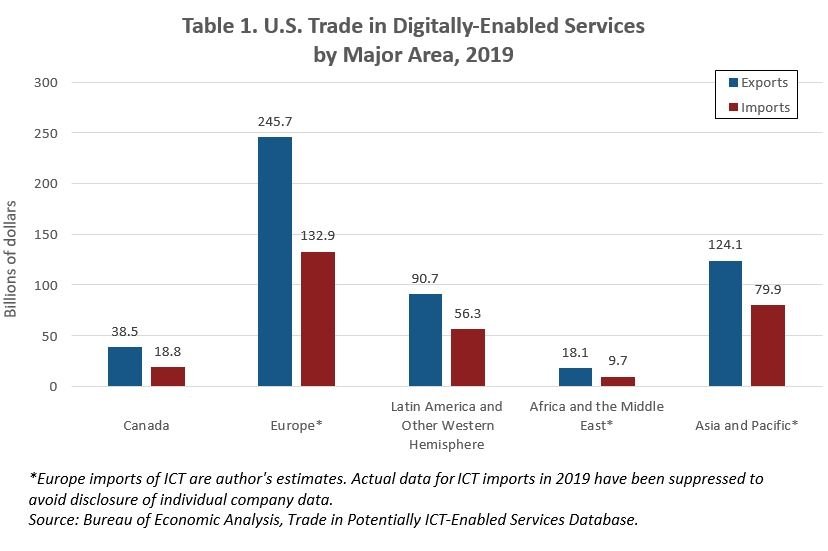
The 27 EU member states collectively exported €1.1 trillion in digitally-enabled services to countries both inside and outside the EU in 2019.[10] EU27 imports of digitally-enabled services were also €1.1 trillion in 2019. Excluding intra-EU trade, EU member states exported €585 billion and imported €622 billion in digitally-enabled services, resulting in a deficit of €37 billion for these services (See Table 2 and Table 3)
Digitally-enabled services represented 55% of all EU services exports to non-EU countries and 63% of all EU services imports from non-EU countries.
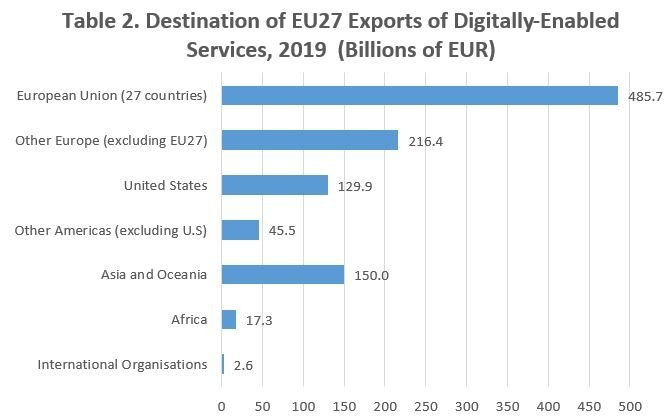
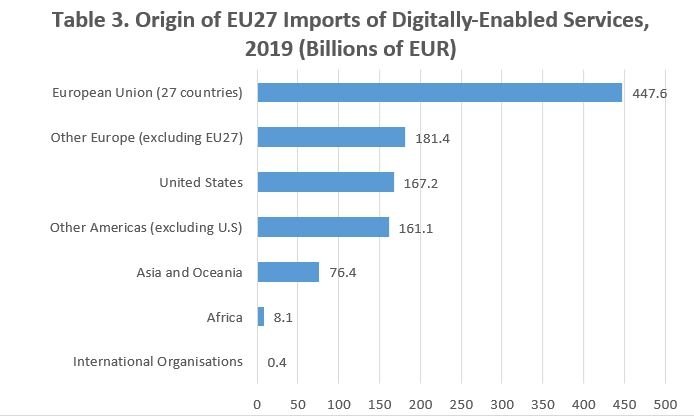
In 2019 the United States accounted for 22% of the EU27’s digitally-enabled services exports to non-EU countries, and 27% of EU digitally-enabled services imports from non-EU countries.[11] The United States purchased €130 billion, according to Eurostat data for 2019, making it one of the largest consumers of EU digitally-enabled services exports.[12]
European countries with the largest estimated value of digitally-enabled services exports were the UK (€261 billion), Ireland (€177 billion), Germany (€173 billion), and the Netherlands (€160 billion).
On the other side of the equation, EU27 member states imported €1.1 trillion in digitally-enabled services, according to 2019 data from Eurostat. 42% originated from other EU27 member states (See Table 3). Another 16% (€167 billion) came from the United States – making it the largest supplier of these services – and 11% came from the UK.
Table 4 categorizes U.S.-EU digitally-enabled services trade into five sectors. For both economies, the most important exports are represented by business, professional and technical services, which accounted for 43% of digitally-enabled services exports from the EU to the United States and 44% of digitally-enabled services exports from the United States to the EU in 2019. The second most important category consists of intellectual property, including royalties and license fees, most of which are paid on industrial processes and software, underscoring how integral such transatlantic inputs are to production processes in each economy.[13] Financial services comprise the third largest digitally-enabled services export category.
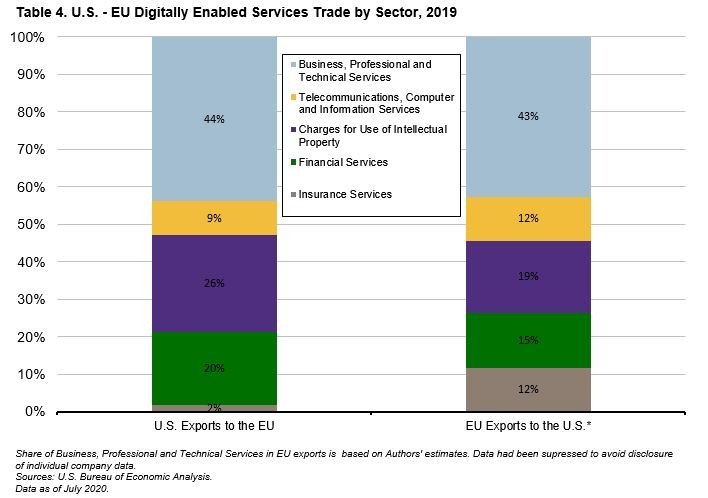
Digitally-Enabled Services Supplied Through Foreign Affiliates
The digital economy has transformed the way trade in both goods and services is conducted across the Atlantic and around the world. Even more important, however, is the delivery of digital services by U.S. and European foreign affiliates -- another indicator reinforcing the importance of foreign direct investment, rather than trade, as the major driver of transatlantic commerce. U.S. services supplied by affiliates abroad were $1.704 trillion, roughly double global U.S. services exports of $875.83 billion. Moreover, half of all services supplied by U.S. affiliates abroad are digitally-enabled (Table 5).
Table 5 underscores the relative importance of digitally-enabled services supplied by affiliates of U.S. companies located in Europe and affiliates of European companies in the United States, versus U.S. and European exports of digitally-enabled services. 52% of the $938 billion in services provided in Europe by U.S. affiliates in 2018 was digitally-enabled. In 2018 U.S. affiliates in Europe supplied $490.51 billion in digitally-enabled services, whereas European affiliates in the United States supplied $273.78 billion in digitally-enabled services. Digitally-enabled services supplied by U.S. affiliates in Europe double U.S. digitally-enabled exports to Europe, and digitally-enabled services supplied by European affiliates in the United States were 49% more than European digitally-enabled exports to the United States.
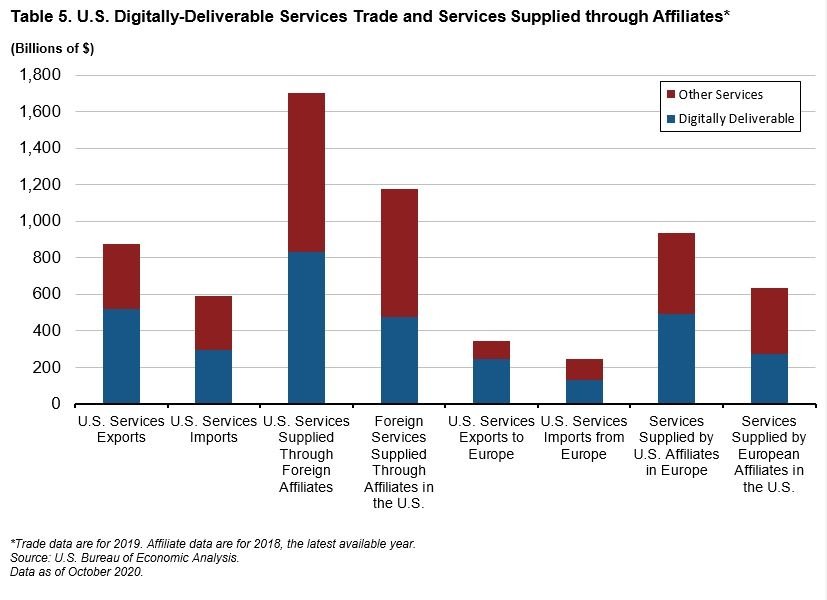
The significant presence of leading U.S. service and technology leaders in Europe underscores Europe’s position as the major market for U.S. digital goods and services. Table 8 underscores this dynamic. In 2018, Europe accounted for 69% of the $289.6 billion in total global information services supplied abroad by U.S. multinational corporations through their majority-owned foreign affiliates. This is not surprising given the massive in-country presence of U.S. firms throughout Europe, with outward U.S. FDI stock in information overwhelmingly positioned in Europe. U.S. overseas direct investment in the “information” industry in the UK alone, for instance, was more than double such investment in the entire Western Hemisphere outside the United States, and 33 times such investment in China. Equivalent U.S. investment in Germany was 4 times more than in China.[14]
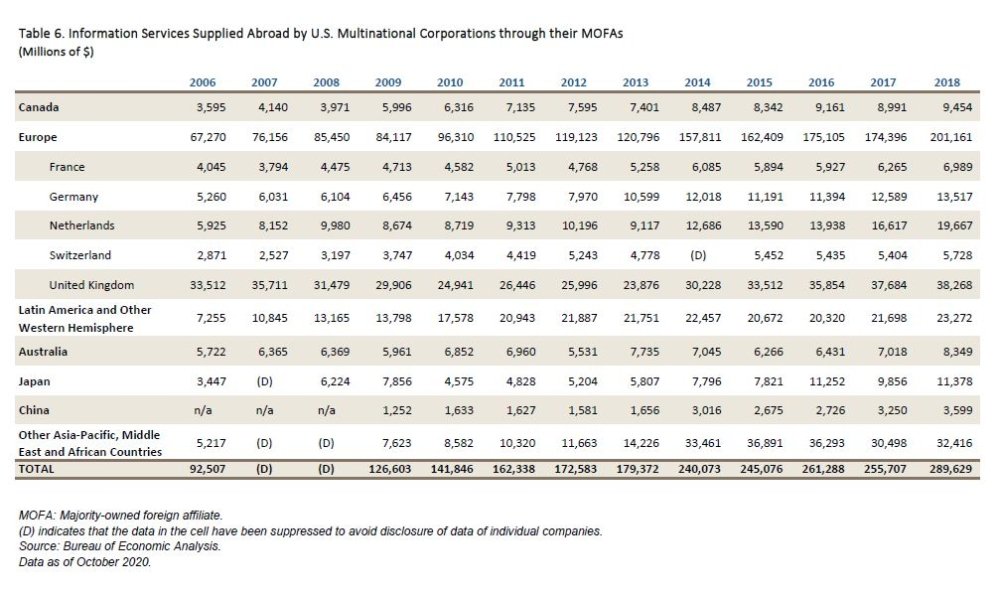
[1] U.S. Bureau of Economic Analysis, Defining and Measuring the Digital Economy Data Tables 1997-2017, April 2, 2019.
[2] The U.S. Bureau of Economic Analysis (BEA) defines those services as including three categories of international trade in services: telecommunications services, computer services, and charges for the use of intellectual property associated with computer software.
[3] The BEA approach draws on work by UNCTAD and the OECD. See BEA International Data, https://www.bea.gov/iTable/index_ita.cfm; Jessica R. Nicholson, '' New BEA Estimates of International Trade in Digitally Enabled Services,'' May 24, 2016, Bureau of Economic Analysis,
http://www.esa.doc.gov/economic-briefings/new-bea-estimates-international-trade-digitally-enabled-services. These products are often referred to as “digitally deliverable” (OECD-WTO-IMF, 2019[50]), meaning that they can, and are increasingly, being delivered in the form of data flows.
[4] https://www.ntia.doc.gov/files/ntia/publications/measuring_cross_border_data_flows.pdf; United States International Trade Commission, “Digital Trade in the U.S. and Global Economies, Part 2”, Pub.4485, Investigation No.332-540, August 2014, p.47.
[5] Jessica R. Nicholson and Ryan Noonan, “Digital Economy and Cross-Border Trade: The Value of Digitally-Deliverable Services,” Washington, DC. U.S. Department of Commerce, Economics and Statistics Administration, ESA Issue Brief # 01-14, January 27, 2014, available at http://www.esa.doc.gov/sites/default/files/digitaleconomyandcross-bordertrade.pdf.
[6] The OECD/IMF/WTO Handbook defines digital trade as “trade that is digitally ordered and/or digitally delivered,” yet data statistics have not yet been aligned to this definition. That leaves us with digitally-enabled services as the default metric. For more, see IMF/OECD, “How to move forward on measuring digital trade,” Thirty-Second Meeting of the IMF Committee on Balance of Payments Statistics, Thimphu, Bhutan October 29–November 1, 2019, https://www.imf.org/external/pubs/ft/bop/2019/pdf/19-07.pdf; Joshua P. Meltzer, “The Importance of the Internet and Transatlantic Data Flows for U.S. and EU Trade and Investment,’’ Brookings Institution, Global Economy and Development Working Paper 79, October 2014; Ryan Noonan, ''Digitally Deliverable Services Remain an Important Component of U.S. Trade,'' Washington, DC. U.S. Department of Commerce, Economics and Statistics Administration, May 28, 2015, available at http://www.esa.gov/economic-briefings/digitally-deliverable-services-remain-important-component-us-trade.
[7] Digital Economy Report 2019, op. cit.
[8] Ibid; Meltzer, op. cit.
[9] Daniel Ker and Emanuele Mazzini, Perspectives on the Value of Data and Data Flows, OECD Digital Economy Papers, No. 299, December 2020, https://www.oecd-ilibrary.org/docserver/a2216bc1-en.pdf, p. 71.
[10] Note that data on EU28 exports and imports of services by product is not available from Eurostat for the year 2019.
[11] Ibid; OECD.
[12] Note that these figures are sourced from the OECD International Trade in Services Statistics database, and can vary from the corresponding U.S.-EU bilateral trade figures reported by the U.S. Bureau of Economic Analysis. Differences can occur in how services are measured, classified, and attributed to partner countries, resulting in asymmetries in the two data sources. For more information on these asymmetries, please see Eurostat report, “Transatlantic Trade in Services: Investigating Bilateral Asymmetries in EU-US Trade Statistics, 2017 edition,” https://ec.europa.eu/eurostat/documents/7870049/8544118/KS-GQ-17-016-EN-N.pdf/eaf15b03-5dcf-48dd-976f-7b4169f08a9e.
[13] Ibid.
[14] While affiliate sales are a more important means of delivery for digital services and digitally-enabled services than cross-border trade, the two modes of delivery are more complements than substitutes, since foreign investment and affiliate sales increasingly drive transatlantic trade flows. The fact that digital services and digitally-enabled services are following this same broad pattern of transatlantic commercial flows reinforces our point that intra-firm trade is critical to the transatlantic economy.
Authors



Global Europe Program
The Global Europe Program is focused on Europe’s capabilities, and how it engages on critical global issues. We investigate European approaches to critical global issues. We examine Europe’s relations with Russia and Eurasia, China and the Indo-Pacific, the Middle East and Africa. Our initiatives include “Ukraine in Europe”—an examination of what it will take to make Ukraine’s European future a reality. But we also examine the role of NATO, the European Union and the OSCE, Europe’s energy security, transatlantic trade disputes, and challenges to democracy. The Global Europe Program’s staff, scholars-in-residence, and Global Fellows participate in seminars, policy study groups, and international conferences to provide analytical recommendations to policy makers and the media. Read more

Explore More
Browse Insights & Analysis
360° View of How Southeast Asia Can Attract More FDI in Chips and AI



